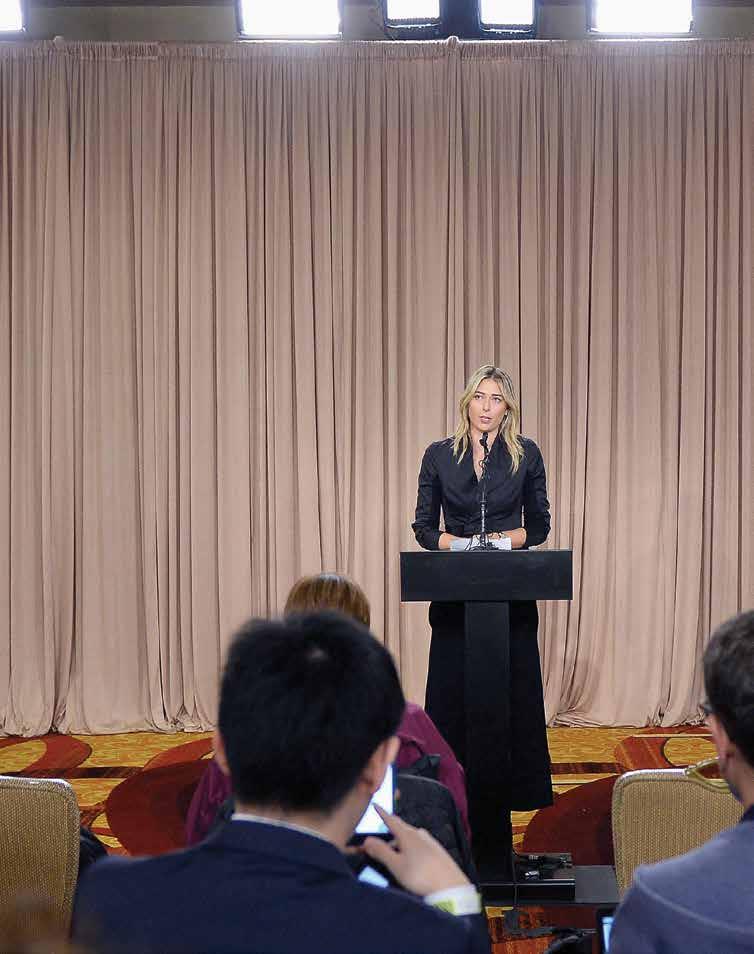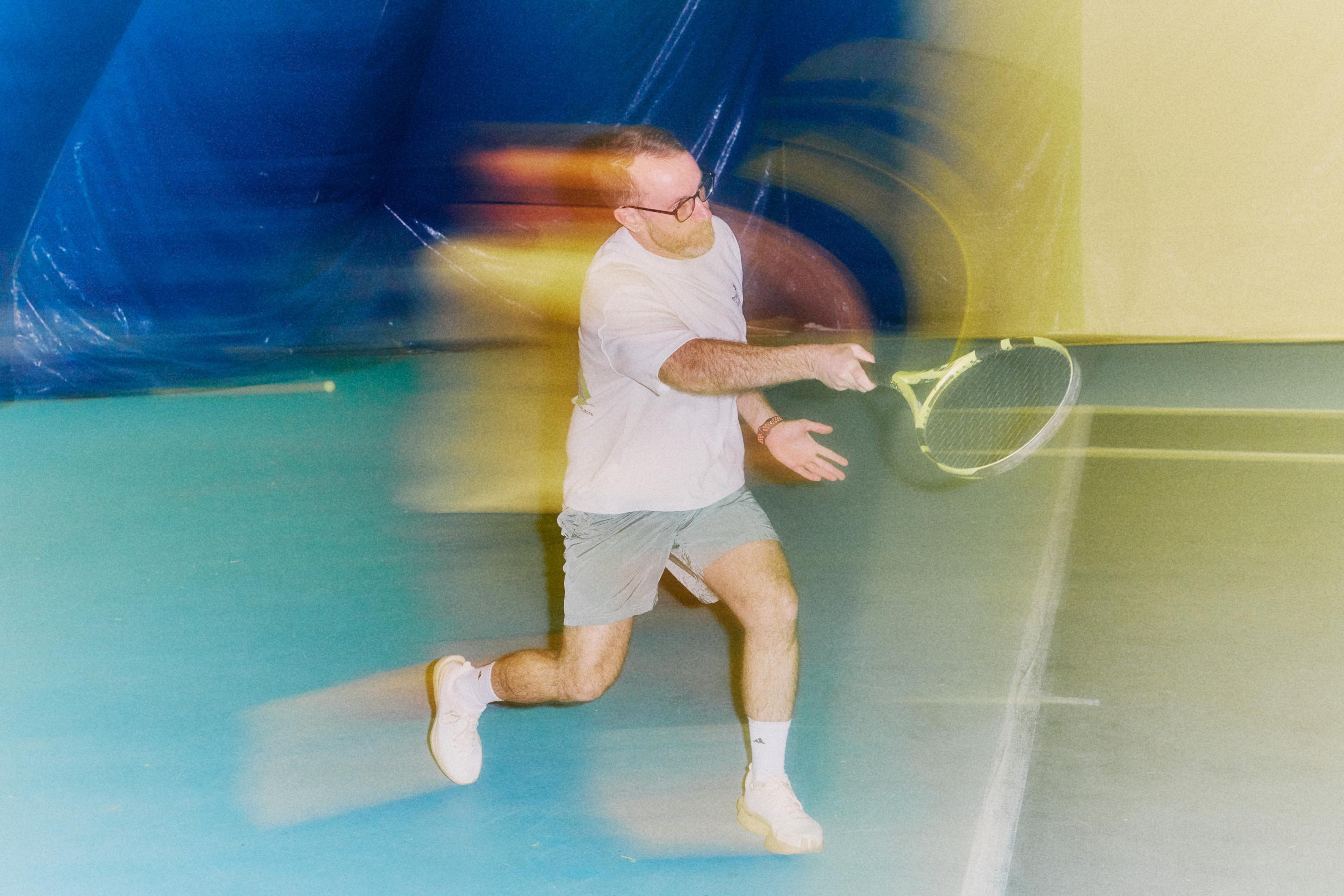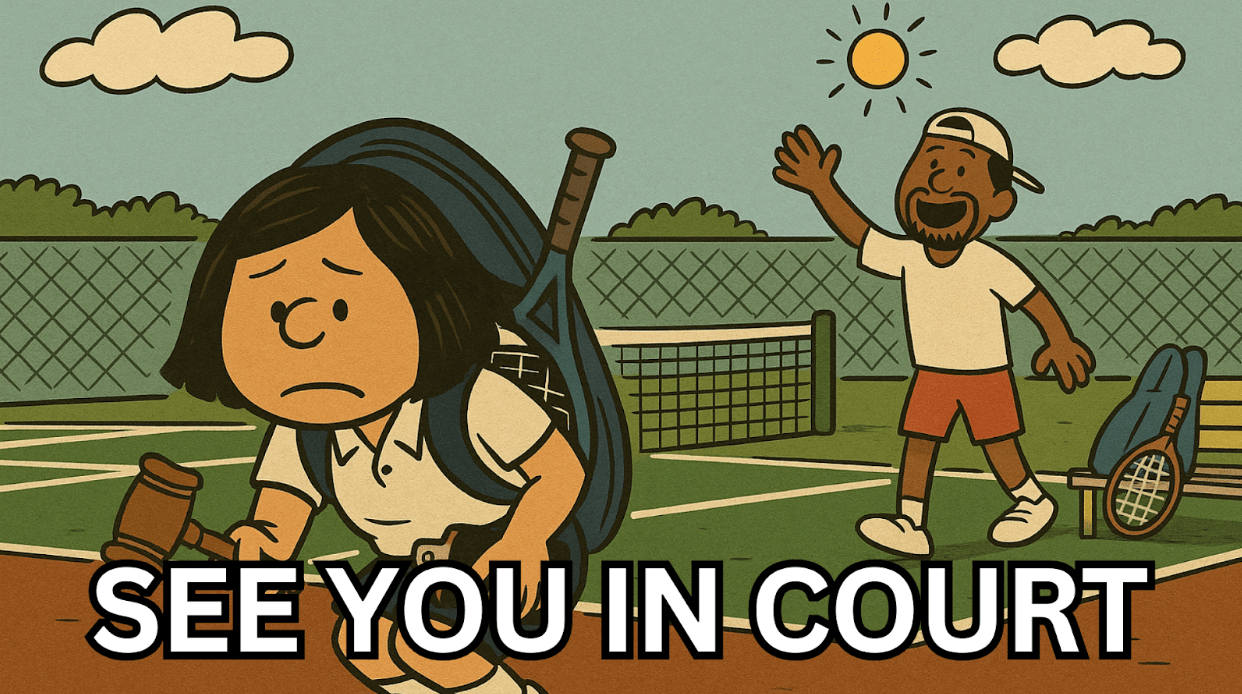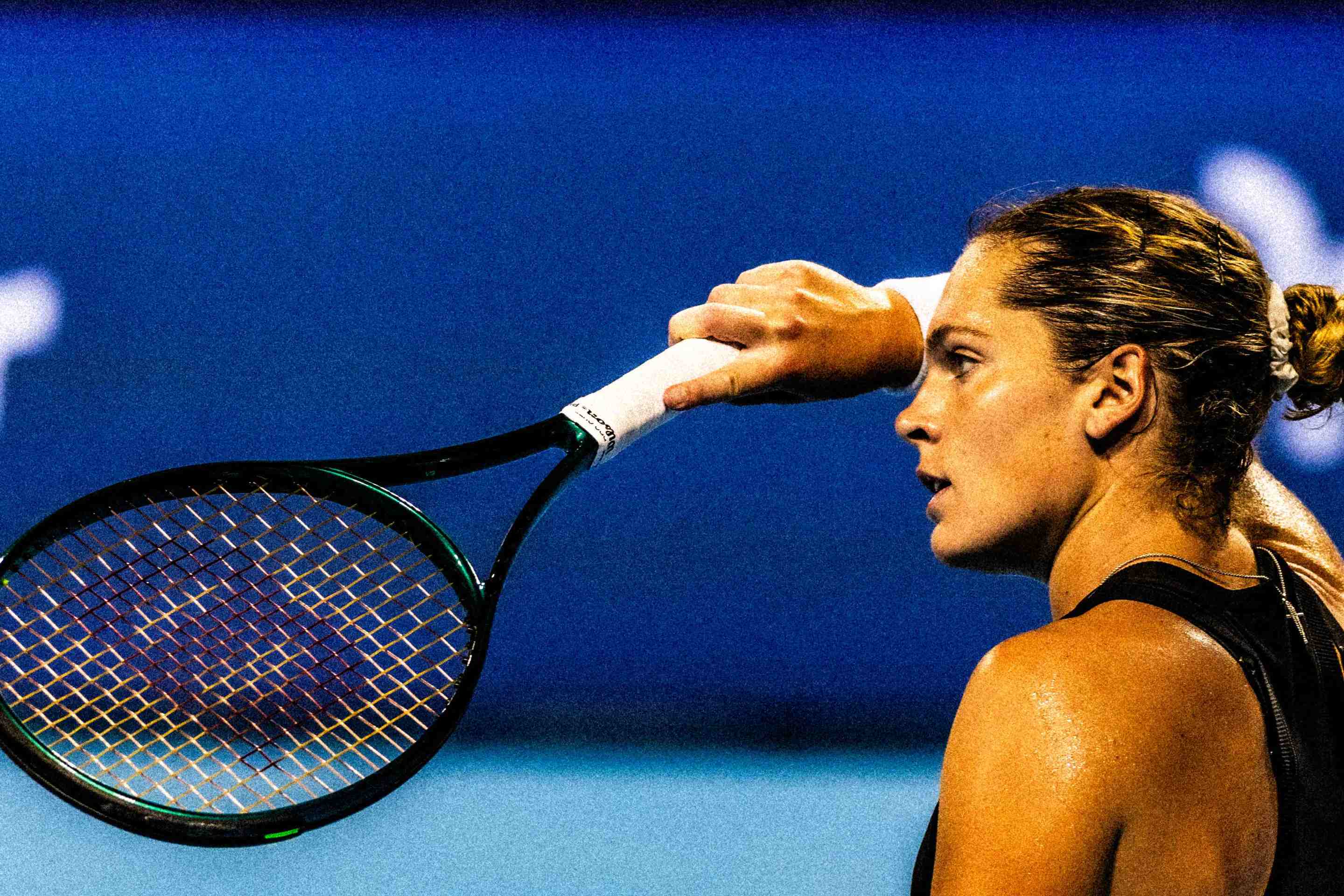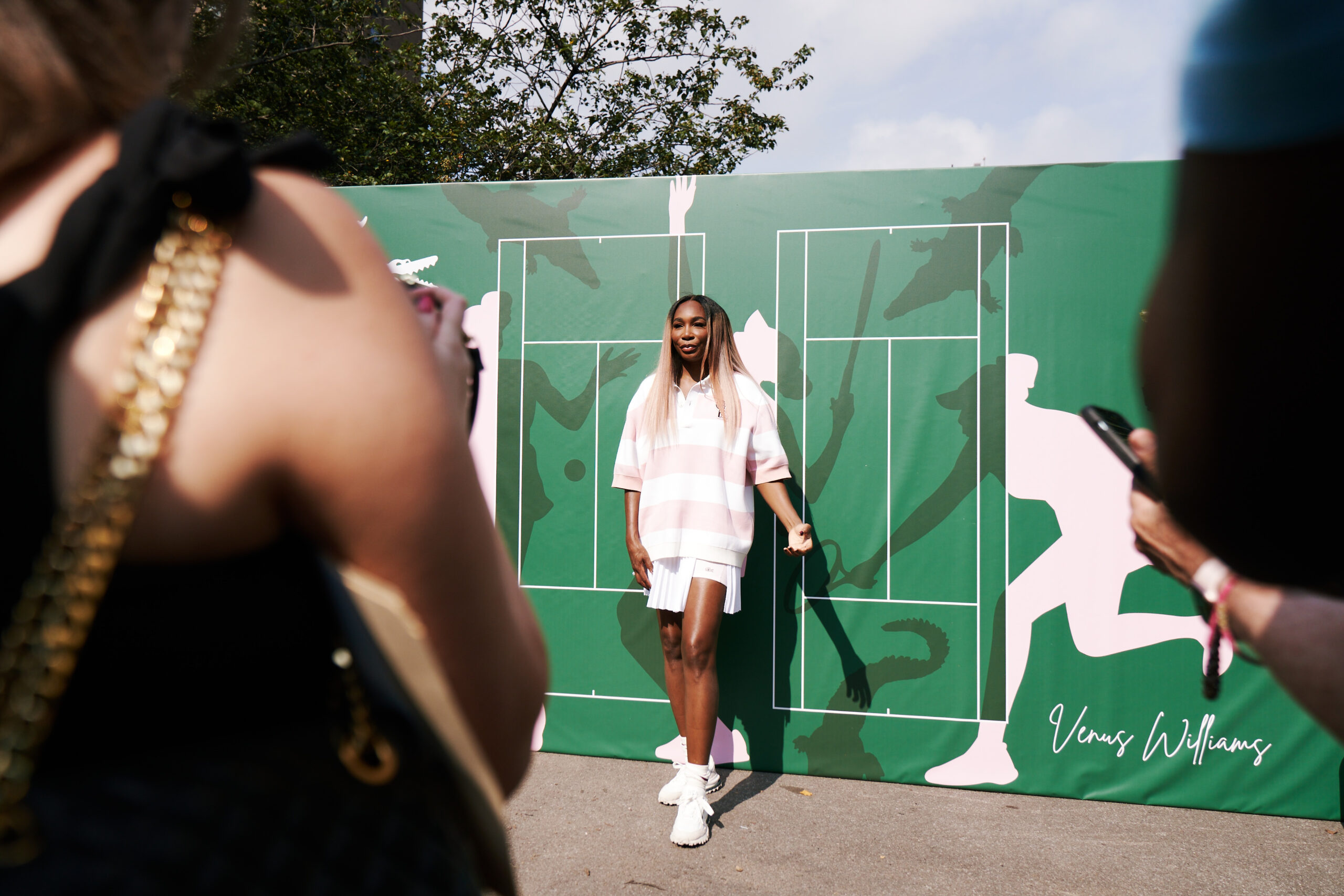To be in the backseat of a car, the cyanotype night on some minor highway, and pass at a distance of one or two hundred yards a rectangle of total green under pooled white lights is to see North American heaven. A community baseball feld, a high school football feld. A tennis court, occasionally. Say you’re a tennis-playing child from an oil town in Siberia where there are no courts, and no oranges, and in photographs of home it’s always snowing or sleeting or for another reason it’s gray. At the age of 6, having frst picked up a secondhand racket on the clay courts in Sochi, of the Black Sea, you arrive in Bradenton, Florida, home of Tropicana Products and the Bollettieri Tennis Academy. Will you ever get over it, the way the green lies shining against the dark? Maria did not. Maria Sharapova was, for a brief lambent time between 2004 and 2006, when she was 17 and 18 and 19, the best female tennis player on grass. She was trained by Nick Bollettieri at the IMG Academy on mostly hard courts, to hone her technique absent variables. She moved on clay, she said later, laughing, like “a cow on ice.” But on grass she was a dancer, a ballerina. One other body moves like hers, and it is that of the actual ballerina Sara Mearns, who shares with Maria a fssive mix of rigor and bounce. Some of Maria’s best serves in the middle 2000s are unbelievable when seen in slow motion. The extension of the right, working leg, reaching à la hauteur. The high toss followed by a hyperbolic swing of the racket, almost dismissive of the ball. Richard Williams, a former chief sportswriter for The Guardian who happens to share his name with the father-coach of Venus and Serena, wrote that a poem about Maria “might start with a description of the moment when she tosses the ball up to serve and, as it reaches its apogee, a line through her left arm and right leg forms a perfect perpendicular.” Which is to say, the girl knew her angles.
Green clay and grass showed Maria to advantage in early photographs. The verdancy made wonder of her coloring, brought out the complementary fush of her cheeks, the gray-green in her cat’s eyes, the analogous streaks of gold in her long straight hair. She looked like a sixth Lisbon girl in Grosse Pointe, as if she’d been away at summer camp while the other fve virgins were suiciding. She wore tank tops and little A-line skirts in white, or pink, or powder blue, obviously from Nike, and a simple gold-plated cross in the Orthodox style. No makeup. Quickbitten nails. Goody-brand snap clips in her basic ponytail. Before each serve, she paused to brush back the newly escaped baby hairs with her ball hand, and the down on her forearm snagged the light. In 2003 she won no matches on the hard courts at the Australian Open nor on the clay at the French Open, but when she got to Wimbledon, to the grass, she beat the 11th-seeded Jelena Dokic and reached the fourth round, where she was beaten by fellow Russian Svetlana Kuznetsova. The tour made her Newcomer of the Year. A talk-show host compared her to Anna Kournikova, and she was ready, saying, “That’s so old.”
At Wimbledon one year later, the turf looked like home. Before beating Serena for the frst and second-to-last time in her career, Maria ended her warm-up 10 minutes early, getting permission, like a bored kid in trig class, to go to the bathroom. Already the boys were crowding on the hill for a free show. She was nervous to be seen. She had only to look in the mirror to see the face of a winner. For days it had been raining; it was in the rain that she’d defeated Lindsay Davenport—“stunned” her, according to the papers—to arrive at the fnal, and now the sun had come through. Her whites were perfect. Her top was thinner-strapped than usual, shoulders so tanned. Her thigh-slit skirt, a new variation on a favorite style, conspired with ankle socks to make her legs look longer than possible. She wore semiformal opalescent drop earrings, and she had the gold cross, the snap clips, and she had altogether the mien of a 22-year-old Gwyneth Paltrow arriving to collect her Oscar in a gum-pink ball gown.
Helen Wills, in her instructive memoir, Tennis, describes a match between two of her fellow lawn stars, Suzanne Lenglen and Molla Mallory, that was unbeatable “for pure dramatic quality.” Lenglen, known in France as “the goddess,” was the most famous female player of the game and would remain among the most memorable. Mallory was then the closest to Langlen in talent, in hard-hitting style, and in fapperish glamour.
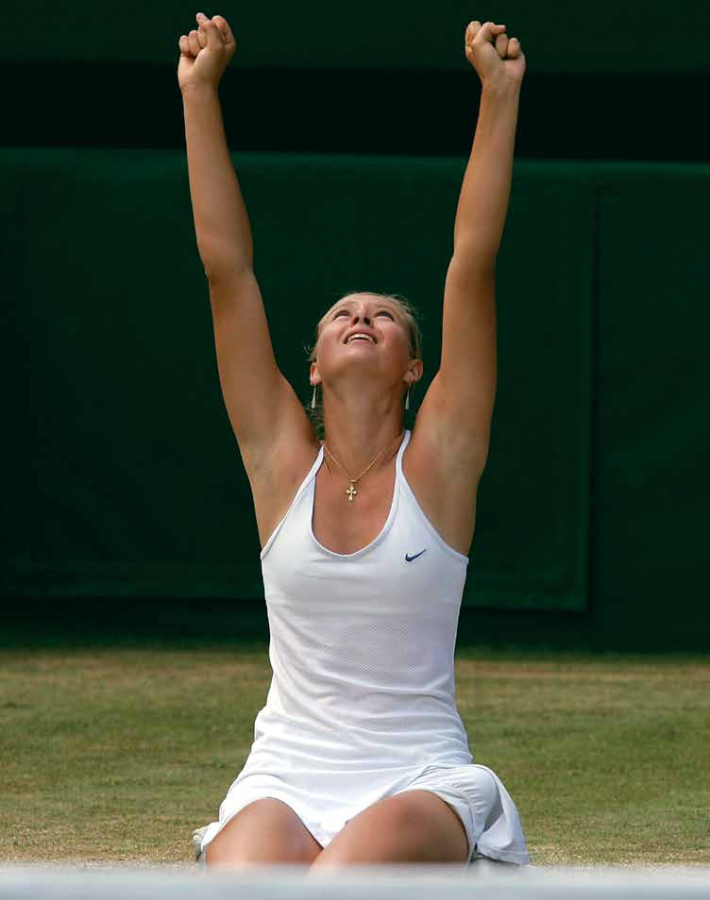
Yet when the two met at Forest Hills in 1921, says Wills, “the contrast at once struck the spectators. The players were both dressed in the conventional white, but the similarity ended there. The bronzed tan of Mrs. Mallory emphasized the pallor of the Frenchwoman. Mrs. Mallory’s determination was evident to every one as she strode along. Mlle. Lenglen danced at her side. The air was electrifed, the audience expectant.”
To the spectators at Wimbledon on July 3, 2004, there could have been no more electrifying contest, no more striking contrast, than that between Serena and Maria. Black and white. Master and novitiate. Serena, smoky-eyed and leonine, all cheekbones and brawn, a woman unmistakable for any other. Maria, new-skinned and from the neck up evangelical-looking, a girl your eyes would only just graze were she clothed and brunet, also maybe not six feet tall. Nine minutes into the frst set, Maria easing ahead of Serena two games to one, the commentator John McEnroe said, wowed, “You forget she’s 17.” Men in the stands, heterosexually doing just that. Some women too, feeling moved. Near the end of the second set, challenged and hanging on to her edge, Maria lobbed back a ball with such celerity and airy precision that Serena didn’t even chase it and Tracy Austin chuckled and said, “Nobody wake her up.” Meaning “her” as in the girl, meaning the girl was following a logic like there was no one before her. “It’s certainly dreamlike tennis,” said the BBC’s “Voice of Wimbledon,” John Barrett.
When it turned out to be no dream, she really had done it, Maria rushed up into the stands to fnd and be kissed by her father, Yuri Sharapov. Her agent, Max Eisenbud, was in the player box “crying his eyes out,” he’d later say. Cameras rolling, high-ranked ofcials waiting, the winner tried phoning her mother on an unbranded cell phone, and fnding herself short of reception she pantomimed adorable frustration to laughter in the stands. She held the Venus Rosewater Dish to her face like a golden refector on a studio shoot.
She was being a bit of a brat, being indulged. “I’m only 17,” she said again and again in postgame interviews. No one would lessen the extraordinariness of her win by thinking she was one minute older. Asked about those million-dollar endorsements, she said she hadn’t had the time to think about it, but joked she would love to endorse a chocolate brand. The sweetest thing she could think of, next to winning. The July issue of Vogue Italia was now on stands, and in it were glam shots of Maria, styled like a rich kid in Mommy’s closet, wearing, in one picture, Byzantine costume jewelry and a real fur coat over a belly-baring green-and-white jersey emblazoned with the words: TRUTH IS NOBODY CAN OUTPLAY ME.
The commentator John McEnroe said, wowed, “You forget she’s 17.” Men in
the stands, heterosexually doing just that.
Maria could sell to the daughters of America, and to the dads who get weird when their daughter’s friends come over aer school.
Two years later, HBO’s Real Sports aired a segment on Maria Sharapova, now ranked second in the world. Included in the segment was a clip, circa 2000, in which a reporter at Bollettieri’s asked a tweenage Maria what she’d rather have, a Wimbledon win or $20 million in endorsements. With Eisenbud sitting next to her, and without appearing to think about it, Maria said, “I would want to win Wimbledon, because then the millions will come.” She would eventually, in 2011, tell a reporter for the New York Times Style section that at the time she was thinking how stupid a question it was, how obvious the answer, but had she been articulating those thoughts, she would have said Wimbledon. You have to earn Wimbledon. She could have said Wimbledon, of course, or Wimbledon. I’m not in it for the money. Even had she answered the same thing with a diferent conjunction— id est, Wimbledon, and then the millions would come—the answer would not be remarkable. What Maria did say, using the conjunction because, made it sound like money was the reason, not the reward, for winning and for wanting to win. She also said will in the clause where in the predicate, echoing the reporter, she had used the subjunctive would, and though it’s less telling to the ear, more likely an error by a kid whose frst language was Russian, the tense switch made the sentence an excellent verbalization of a low ball being dispatched at midcourt by a big swinging volley, her signature move.
Replay the tape of the 2004 Wimbledon women’s fnal from an au courant perspective and there’s something a lot less winning about Team Maria. Eisenbud is wearing wrap-around sunglasses, so there’s no way to see if he’s crying. Maria’s father keeps kissing her face, and almost her mouth, until she looks impatient or actually uncomfortable. The emphasis on her unadvanced age registers as a message not to commentators, not even to competitors, but to brands: Maria could sell to the daughters of America, and to the dads who get weird when their daughter’s friends come over after school. She could and did sell Hondas in Japan and Land Rovers in America, digital cameras for Canon and, of course, fip phones for Motorola, which sponsored her 18th birthday on April 19, 2005, and made her a Centre Court cake. Sports Illustrated cast her as the only athlete in the 2006 Swimsuit Issue, photographing her outside her new Manhattan Beach house. She was what a tennis player should look like. She wanted, or said she wanted, what every female athlete should want: to be a Bond girl. By some lights she was already a Cold War fantasy, the fnal achievement of secret eugenics in Russia, a sleeper agent shaped like a dream. When a slavering men’s-magazine writer went to impress on her his love of Dostoyevsky, asking who her own favorite countryman of letters might be, Maria non-answered, “Well, Pushkin is the most popular.” At times her brain served no purpose but to train her eyes on the very top spot, not top as in scoring but as in selling, misnomered or not as top-earning. She had only to win enough to play on and she would become the most popular and hated, the true-born frst lady of the sport—the Ivanka Trump of tennis.
Never off message, she seldom admits to being unrelatable.
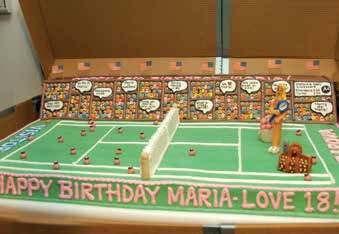
GETTY IMAGES
Maria is now 30, the age at which women stereotypically stop celebrating birthdays. Like a model who gets into acting, or an actress who “wants to direct,” she has become a designing woman who captivates sportswriters, a mogul on the make taking crash courses in “executive education” (like adult learning, but for the superrich) at Harvard Business School. At every game, by contract, she wears outfts by Nike, which she helps design, accessorized with Tifany’s jewelry. In 2005 she told Vogue, “I want to be classy, but I also want to be edgy. If somebody’s wearing black, I want to wear red. I always want to be diferent,” and in 2011 she told The New York Times, “I want to be diferent. If everyone is wearing black, I want to be wearing red.” In 2015 she tweeted, from the Nike showroom, a picture of herself holding up a T-shirt with the motto “girl’s best friend” over a pair of running shoes, captioning it “I thought diamonds were a girl’s best friend?!” with the hashtag falseadvertisement, the hashtag justdoit, the hashtag withdiamonds. That’s just how she does it, by keeping Nike and Tifany’s equally happy, and by keeping her image girlish, not too grown or too worldly to ruin memories of her as a teen.
The “personal life” section of Maria’s Wikipedia page comprises four neat, scandal-free lines about her relationships with men (the occasional faint rumors that she is a lesbian have never gotten media play, maybe because she is said to have approximately zero friends in the women’s locker room to confrm or deny). Engaged in 2010 to the NBA’s Sasha Vujacic, she wore a nine-carat cushion-cut diamond until spring 2012, and in the summer, when breakup rumors surfaced at a press conference, she seemed annoyed the media hadn’t noticed sooner, saying, with a short little laugh, “I was waiting for someone to actually ask me that question.” She does not, as a rule, refuse comment, except to avoid contaminating her meta-brand by a political statement. On the subject of Vladimir Putin’s antigay laws, she told a New York Times reporter in 2013 that “time will address this issue,” noting both her pride in being Russian and her possession of “gay and lesbian friends.” A year later, with the Olympics in Sochi and with the issue not yet addressed by time, Maria informed reporters that she had said “everything I wanted to say about it.”
Never of message, she seldom admits to being unrelatable. To sell the perforated-leather ballet fat she “insisted” Cole Haan include in its Maria Sharapova Collection of sportif accessories, a co-branding efort begun in 2009, she remembered that, yes, she is tall enough to go without heels: “I came in [to the design meeting] saying, ‘You know what? I’m six-foot-two and I don’t care about anyone else.’ I’m going to be selfsh and say I love ballerinas.” Usually the pitch is softer and broad. To sell the foral-fruity fragrance Avon Luck, for which she became the avatar in 2014, she remembered “the frst bottle of perfume my mother bought me,” though she did not seem to remember its name.
To Vanity Fair, she explained that when she came to America as a child, she was amazed at the variety of gummies sold in shops, a possibly apocryphal story whose moral is clear: Only someone born to be an American would take the preponderance and number of different flavored and branded candies as inspiration to make more candy.
To sell the semiluxurious line of sun-protection products, Supergoop!, that she has co-owned since 2014, she remembers that while training in Florida “the application of sunscreen became a ritual.” In a behind-the-scenes video for Evian, circa 2012, Maria promotes the brand’s ethos—“live young”—by making believe that after a long day at practice she comes home to “moments of laughter that are really playful that you don’t really think about.”
Her biggest solo project, no less an efort to sell us on the idea that she’s having fun, is Sugarpova, est. 2012. A half-eponymous, cutely packaged, and uninventive confectionary brand specializing in gummy lips and tennis ball gum, Sugarpova sells at airport gift shops, exurban mega-malls, a West Coast sporting-goods chain, and a Manhattan “candy bar” owned by Dylan Lauren, daughter of Ralph. “I’ve always had a sweet tooth,” Maria confessed to People magazine, to Jimmy Kimmel, to each of a dozen other media outlets. To Vanity Fair, she explained that when she came to America as a child, she was amazed at the variety of gummies sold in shops, a possibly apocryphal story whose moral is clear: Only someone born to be an American would take the preponderance and number of diferent-favored and -branded candies as inspiration to make more candy. The frst time she did not mention her sweet tooth in an interview about Sugarpova was on CNN’s Quest Means Business, where instead she said, “I wanted my own brand.” Maria was, for 11 straight years, 2004 to 2015, the highest-paid female athlete alive, and she is still, reportedly, the richest in history.
Serena is the second-richest, and the winningest. A Nike ad for television, “Unlimited Greatness” (2016), charts the rise, fall, rise, and…rise of Serena Williams with keywords like “struggling” and “legend.” The penultimate four words are “greatest female athlete ever,” the “female” erased to leave the ultimate three.
Suddenly, at the hotel podium, she seemed more alone than she’d ever been on court.
Contrast this with Nike’s last memorable minute-long ad featuring a female tennis player, “I Feel Pretty” (2006), in which the staf and guests at the Waldorf Astoria and the players, ofcials, and fans at the U.S. Open take turns singing the titular song (from the musical West Side Story) while eyeing Maria Sharapova with suspicion, envy, lust, dislike, occasional wide-eyed admiration, and mock obsequiousness—that is, until she hits the ball with her infamous pre-orgasmic shriek and an awed silence falls. (Intended to be subversive, the message was somewhat undercut by the fact that 57 seconds of the ad show Maria being “pretty,” albeit determined and pointedly not vain, and six seconds show her being “powerful.”) The punchline, delivered by an announcer, was tongue-in-cheek—“that’s pretty good stuf already”— but bespoke a real understanding: Maria was pretty, and pretty good, but Serena was great. She has now beaten Maria 18 straight times, most recently in the quarterfnals at the 2016 Australian Open, where the champion walked on court to Katy Perry’s “Roar,” the onetime contender to Taylor Swift’s “Shake It Of.” If Maria is not the Ivanka Trump of tennis, she is at least the Taylor Swift, and Serena the Beyoncé, which is to say that the legend of “a skinny little girl” beating “a great champion with enormous physical strength” is no longer “just an amazing win that struck a chord with everyone,” as Eisenbud put it, but an upsetting demonstration of the tennis world’s elitism and racism.
On March 7, 2016, Maria took the podium at a downtown Los Angeles hotel to make a surprise announcement to the media. Some had thought she was retiring, prompting her to begin by quipping she’d never announce her retirement “on such ugly carpet.” Instead the news was more than surprising: Maria, one of the cleanest-living players, the one who drank nothing but Evian, had just been informed she’d failed a drug test. Shaken but still in character, attempting to stage-manage the story, she explained that the drug in question, meldonium, had been prescribed by her doctor for “several health problems” in 2006 and that, having taken it unquestioningly since, she failed to notice when on January 1, 2015, the drug was banned. “Russian tennis phenom Maria Sharapova instantly made…meldonium famous,” one story began, as if wonderingå whether there’s anything Maria can’t sell. Doctors were called up to say that meldonium not only reduces heart stress but also hypes blood fow and streamlines metabolism, with little-known and likely negligible efects on performance (and unknown side efects). John McEnroe gave the most honest opinion in the tennis world, saying that if the drug had been around in his prime, he would obviously have taken it too, as athletes “have been looking since the beginning of time for an edge.” Still, he found it “hard to believe that no one in her camp, the 25 or 30 people that work for her, or Maria herself had no idea that this happened.” In its decision to suspend her for two years, the International Tennis Federation took the opposite angle, declaring Maria “the sole author of her own misfortune.” When she was fortunate, her successes had been credited in part to Team Maria, or to Brand Maria, and no story would be complete without reference to her father, her agent, her coaches. The video shot live from the downtown Los Angeles hotel made her look lonesomer than she ever had on court.
Few of her peers and competitors came to her defense. Serena was graceful, noting her ex-rival’s “courage and heart.” Caroline Wozniacki, who happens to be Serena’s best friend, was rather less so, and stressed that “as athletes, we always make sure there’s nothing [we take] that could put us in a bad situation.” Caroline and Serena were, in this formulation, the athletes, or the real athletes, and Maria was not. According to Kristina Mladenovic, “all the players were saying”— and apparently had believed, or had wanted to believe—“she’s a cheater.” The New York Post ran a helpful explainer titled “Why Everyone in Tennis Hates Maria Sharapova.” On the third day of Wimbledon, the Daily Mail ran a piece titled “Maria Sharapova isn’t missed…because she is ‘totally unlikeable.’” Another ex-boyfriend, the Bulgarian tennis player Grigor Dimitrov, said at the China Open that the sport did miss Maria, but then, seeming not to miss her himself, added that she’d deserved the two-year suspension. A day earlier the Federation had announced that Team Maria had won an appeal, and that the suspension was now reduced to 15 months. Tour ofcials began openly debating whether the major tournaments should grant an unseeded Maria the opportunity, via wild cards, for a comeback. The Porsche Grand Prix in Stuttgart became the frst tournament to do so, a perhaps unsurprising move as Porsche was the last of four major sponsors, after Nike, TAG Heuer, and Avon, to quit working with Maria mid-scandal and the second, after Nike, to begin again (Evian and Head Rackets continued supporting her without pause). Caroline Wozniacki, again saying what her best friend cannot, called the decision “questionable,” the result “disrespectful,” the rules “twisted.”
Casual or younger observers, like uncharitable or younger competitors, fnd it easy to forget or ignore how much Maria has done for tennis, can look eye-rollingly at all her endorsement deals and think she’s done more for herself. Her career is a “cash cow.” Her looks, attitude, and asocial focus make her an “ice queen.”
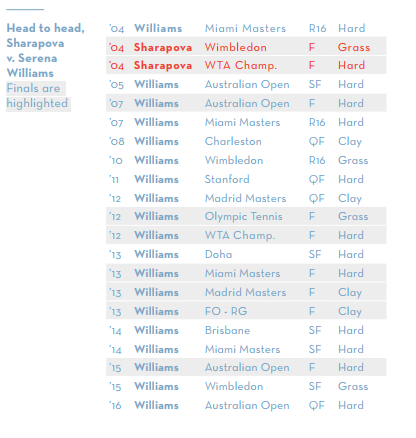
These angles show less than half the story. After she started slipping on grass, after she switched up her serve and damaged her shoulder and switched up her serve again, saying what her best friend cannot, called the decision “questionable,” the result “disrespectful,” the rules “twisted.”
Casual or younger observers, like uncharitable or younger competitors, fnd it easy to forget or ignore how much Maria has done for tennis, can look eyerollingly at all her endorsement deals and think she’s done more for herself. Her career is a “cash cow.” Her looks, attitude, and asocial focus make her an “ice queen.” These angles show less than half the story.
Maria is four years past the age at which she expected to retire, but she is also five years younger than Serena, leading some to believe she will once again, if only once again, beat the greatest.
After she started slipping on grass, after she switched up her serve and damaged her shoulder and switched up her serve again, Maria became one of the winningest players on clay, second only to Serena as usual, a transmutation summed up by ESPN’s Nick McCarvel as “perhaps the most astonishing narrative of an already Hollywood-esque career script.” Even compliments like these, though, suggest that her wins are scripted, her incredible on-court presence staged, her whole career rigged. “Few people seem to realize,” wrote NBC’s Joe Posnanski in 2014, “that Maria Sharapova is an all-time great tennis player.” The reason he gave was “her almost-pathological inability to beat Serena Williams,” who may have an equally specific desire to punish the girl who embarrassed her at the world’s most prestigious tournament, and worse, who stole the audience’s love. For all her “periodic letdowns” and “weird funks,” he explains, “Serena…is never of her game against Sharapova, never lets down even a little against Sharapova.”
Maria is four years past the age at which she expected to retire, but she is also fve years younger than Serena, leading some to believe she will once more, if only once more, beat the greatest. She has faced few other serious rivals. Unfortunately for Eugenie “Genie” Bouchard, the 23-year-old Canadian player who was widely, prematurely hyped after rising to the Wimbledon fnals, but losing to Petra Kvitova, in 2014, and by early 2016 was outside the top 50, it takes more than natural blondness and preternatural guts to be titled “the new Sharapova.” Maria has a 4–0 record against Genie and was said to “crush” her, in straight sets, after taking “a stern phone call” from her dad, at the 2015 Australian Open. She is 6–4 against Caroline Wozniacki, who was world No. 1 in 2010 and 2011 and ended 2016 as world 19th, while Maria climbed back to second place in 2012 and 2014 and ended 2015 as world fourth, only weeks before failing her drug test. No drug could account for her longevity. Generally speaking, another thing hard for casual observers to see is the big deal with “doping,” given how many Oscar-winning actors get liquored up for nude scenes or sobbing close-ups, how many award-winning graduates of Ivy League colleges take Ritalin, how many beauty-pageant winners take weight-loss pills. Sport is meant to be the purest meritocracy, but purity at large has a deserved reputation for being mythic.
If she is permitted to try winning again at this year’s Wimbledon, Maria may fnd that her deals with Evian and Head are extended for a few extra seasons, but by now it’s absurd to think of her playing for endorsements. She has a solid shot at continuing with Nike in any case, designing tennis whites like Michael Jordan designs shoes. She has godlike amounts of money, enough money, she has said, to feed her great-grandchildren, and she has a mansion in Bradenton, which she considers home and occupies alone. Retiring to wealth, however it may have appealed to the 19-year-old Maria, complaining to Vogue that her family “never had the nicest house, the nicest car, the nicest clothes,” is now not the narrative choice. Returning in service to a dream is a likelier story, even if it is a cliché. The only gift for a girl who has everything is a chance to prove she deserves it. When Maria frst fell in love with the grass at the All-England Lawn Tennis Club it was 2002, and she had competed in the tournament as a junior, and had lost in the fnal. “I was one of the last people leaving the site,” she recalled to a newspaper reporter in 2014, on the 10th anniversary of her win, “and it was quite late and nearly dark. It’s a bit eerie really to leave when there’s nobody there and the tournament has fnished…. As we were driving away I remember looking back and thinking how special it was. I was probably upset because I’d lost in the fnal. I was thinking about the match and all the what-ifs, but I looked back and thought how beautiful it was, how I couldn’t wait to come back.”
Sarah Nicole Pricke is the founding editor of Adult magazine. Her writing has appeared in or on Artforum, Bookforum, Dazed & Confused, The Hairpin, Hazli, Interview, The New Inquiry, The New York Times Style Magazine, n+1, and more.
Featured in Racquet Issue No. 3
